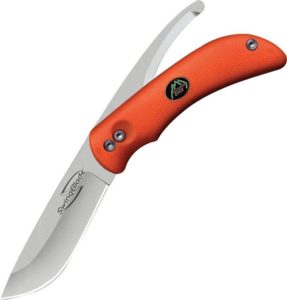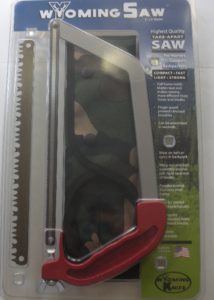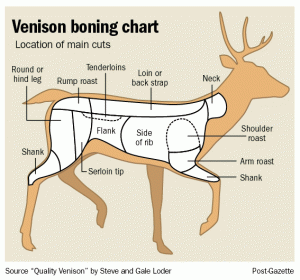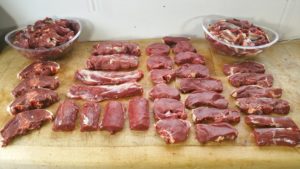10 Oct GUT IT OUT!!!
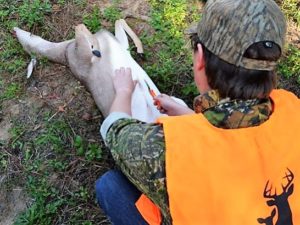
Here are some tips to give you an edge.
Latex gloves. For a beginner, get the shoulder length disposable gloves. They will need them. Standard size latex gloves are useful for all kind of sanitary needs. Not only are they important when dressing a deer, they come in handy when you are butchering, cooking, administering first aid, cleaning guns and gear, or handling fuels, paint, or chemicals. Keep some in your kit, vest, and vehicles.
Sharp knives A sharp knife is safer than a dull one. A proper edge will allow you to quickly cut what is needed. Have a sharpener handy if you need to tune your edge. This is important when dealing with elk, moose, antelope, or mule deer with thick hair.
Zip ties Once you cut the deer’s anus, pull out the intestine and seal it tight with a zip tie. You can also use string or wire. This prevents any scat from dropping into the cavity.
Wyoming Saws You don’t have to remove the whole critter. Check regulations in your area. Usually, you need to leave proof of sex attached to the rear leg. The rest can be quartered and put into cotton game bags. The heart and liver can be placed into plastic zip bags. The Wyoming Saw is a great packable cutting tool to split the pelvis, remove lower legs, and cut the spine. This reduces transport weight.
Meat bags Cloth bags work best, never use plastic trash bags, Plastic keeps the heat in and provide a moist environment for bacteria and germs. Cheese cloth mesh type bags fit nicely around the meat, allows the meat to breath, and keep off insects. Once you transport the meat, get in on ice asap.
Deer transport Dragging your deer in the dirt is not the best way to transport a deer. Deer carts, wheelbarrows, slides, and dollies allow you to get your critter to the truck or camp quickly. Minimize dirt and grit getting into your meat. Once in camp or in your garage, hang the carcass up so it can cool. It is best to hang the carcass head down so that drainage goes into areas that will not be eaten. For a more tender deer, hang it head up but from the neck’s spinal bone. This way the deer ‘s muscles will be relaxed and not stretched. This is a good way to age your deer.
Hand sanitizer Once you have gutted the deer, clean your hands using these handy wipes. Snow, grass, water, or even dirt will help clean your hands. With luck, your gloves kept most of the yuk off you. Place the wipes inside the inverted latex gutting gloves and dispose of them properly. It is best to carry them back to camp. These gloves and wipes can make other animals sick.
Directions DO YOUR HOMEWORK! Google it! You Tube videos allow you to learn visually. This will work afield if you have a cell phone signal. If not, print out some step by step directions. Having a mentor that will walk you through the gutting process is priceless. Gutting is not a spectator sport.
Other tips! When cutting the pelvis, and anus, be careful of the bladder. Having some paper towels will allow you to avoid leaks that will taint your meat. If you can remove the bladder intact, and full, place it into a baggie and use it as a hunting scent. Place it in a scrape or use it as a fresh, real buck lure. This golden nectar can be priceless. Don’t waste it. If you are tagged out, give it to a friend. You can also save the dark hair patches found in the rear inner knees. These scent glands are great buck attractors. Use safety pins to attach them to your pant legs. Store them in a plastic bag.
The “Fish” or inner loins are close to the bladder. Be careful to remove them intact and urine free. Place them into a bag for dinner. This small pair of loins are the most tender and delicious cut of meat on a deer. I am amazed at how often they are left to dry out inside the carcass.
Hanging your deer for days and a week is fine if the temperature is below 40 degrees. A walk-in fridge is a better choice. Quartered meat in the cloth bags can be refrigerated for a week or more. Don’t freeze the meat until it is butchered.
Butchering your own deer saves money and is an important part of the process. Too many hunters give away their harvest because they are lazy, inexperienced or just want antlers or the thrill of the hunt. Shame on them! It costs around $75 to have a deer butchered. Throw in some special cuts and sausage, add some pork to the grind and the price quickly jumps to $10 or more. Invest this expense into some butchering gear, A meat saw, boning knives, steak knives, grinder, and a vacuum sealer will pay for itself. An average dressed deer will weigh in at 100-150 lbs. Take off the hide, head, bones, fat, and waste. Now you have edible clean meat. Once made into steaks, roasts, chops and grind, you will end up with 35-50 lbs. of packaged meat. Label the packages with a date and the cut of meat. You can freeze the harvest for about 6 months, for best quality.
Now you have this magnificent and delicious deer in front of you and you give it away!? Are you crazy? This meat is more expensive and tastier than prime beef. Bows, guns, gear, stands, camo, accessories, leases and licenses add up in cost. You already learned how to become a hunter, now finish what you started and enjoy the best parts.
White-tailed deer are delicious, organic, and healthy. If you give some meat away, supply recipes. The key to cooking deer properly is not overcooking it. Medium rare is best. Presentation will also make for a more gourmet meal.
Celebrate the hunt long after the work is done!
Montana Grant
For more Montana Grant, hunt him up at www.montanagrantfishing.com.


